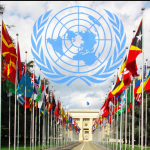Having won the March 22 repeat ‘presidential’ election, Aslan Bzhania is now the Moscow-backed fifth leader of separatist Abkhazia for a five-year term. Bzhania was the first presidential hopeful in Abkhazia to give an interview to the Georgian media during the election campaign. Speaking with Interpressnews on January 16 and and several times afterwards , including recently in August (see here and here) he and the new Secretary of the Security Council of separatist Abkhazia – Sergei Shamba, declared the necessity for direct Georgian-Abkhaz dialogue, aside from the talks occurring within the Geneva International Discussion format since 2009.
It is, unambiguously, not clear what idea the proposed dialogue can have and how it should be carried out, but without a dialogue with the Abkhazians the conflict in the region cannot be resolved.
On 27 September 1993, the Head of the Council of Ministers (and Security Council) of the Autonomous Republic of Abkhazia – Zhiuli Shartava, who directed the operation for protection of the government house, was taken hostage (together with other Georgian fighters) and shot by an Abkhazian separatist group. 27 September marks the day of the fall of Sokhumi… 27 years have elapsed since then.
It is self-evident how difficult it is to talk about a dialogue with Abkhazians in this context, especially as Abkhazians also died in this war.
Apart from this and notwithstanding the direct involvement of Russia in the conflict, it is essential to establish a dialogue with the Abkhazians, for the very first phase of eliminating the preconditions of the conflict. Dialogue is necessary, first and foremost, to discuss the regional status of Abkhazia (nationalism is much stronger in Abkhazia compared to South Ossetia). This has to be an expanded autonomy, within the framework of asymmetrical regionalism or asymmetrical federalism, despite the fact that the Abkhaz separatist government has started an illegitimate secession process. From the Georgian side, discussions offering the specific model of autonomy need to begin.
According to the Georgian constitution, Abkhazia has the status of an autonomous republic. According to Art. 7, para. 3 of the Georgian Constitution, “the state territorial arrangement of Georgia shall be revised by a constitutional law of Georgia on the basis of the principle of the separation of powers after the complete restoration of the jurisdiction of Georgia over the entire territory of the country.”
Therefore, the constitutional law on the Abkhaz Autonomous Republic does not exist and the territorial arrangement has not yet been revised since Georgia gained independence in 1991. In this context, it is necessary to define which form of territorial arrangement is acceptable for Georgia given the status of the conflict regions. Georgia is currently a unitary state with regional autonomies.
It is obvious that the aspirations of the Abkhazians should have a legitimate basis and the status of Abkhazia must be determined within the framework of current international law/constitutional law.
As such, it is important to understand the right of peoples to political self-determination and the prerequisites for exercising this right. The notion of expanded autonomy for the Abkhazia and Tskhinvali regions should be seen as a result of the implementation of this right.
The right of peoples to political self-determination in the modern sense developed in the 20th century. In the early 1900s, the right of all peoples to political self-determination gained international support, followed by successful secessionist movements during the First and Second World Wars and the period of decolonization in the 1960s.
The right of peoples to political self-determination as a political principle in the early stages of development encompassed the doctrine of nationalism, which was implemented in the French and American revolutions. During the First World War, the Allies viewed the right to political self-determination as the goal of peace. As part of his 14-point program, US President Woodrow Wilson saw the right of peoples to political self-determination as an important goal for the period after World War II. The result was the collapse of the Austro-Hungarian and Ottoman empires and the formation of the Baltic States. The United Nations’ predecessor, the League of Nations, also recognized this principle, but the United Nations is the organization that has relatively fully defined this right.
The right of peoples to self-determination emphasizes the legal right of the people to determine their own political fate according to international law. The right of peoples to political self-determination is an important principle of international law, which is derived from customary international law, but is also recognized as an essential legal principle and is defined at the level of international treaties. For example, the right to political self-determination is recognized in the United Nations Charter and in Art. 1 of the two Covenants on Civil and Political Rights and on Economic, Social and Cultural Rights (1966). Furthermore, the Friendly Relations Declaration of the UN General Assembly (1970) recognizes the right to self-determination, which entails the right of all peoples ‘’freely to determine, without external interference, their political status and to pursue their economic, social and cultural development” (Principle 5).
The modern perception of this right includes the “internal” and “external” dimensions. The “internal” context of political self-determination focuses on the social and political rights of the state (the question of granting so-called expanded autonomy for Abkhazia can only be discussed in this context), while the “external” context focuses on the possibility of achieving state independence in general.
Accordingly, the UN Charter recognizes two types of peoples’ political self-determination. First, people have the right to political self-determination, including the right to choose the political system in a political, economic, social and cultural context. Secondly, the right to political self-determination is defined as the right of peoples to constitute themselves within the existing state or to realize it in any other form based on free choice, which is statistically linked to the existing state. Both versions have their roots in the United Nations Charter (Article 2.1; Article 55.1).
The right to political self-determination had different practical meanings at different times. In the past, it was often viewed as a political rather than a legal principle. Although the United Nations Court of Justice has recognized peoples’ right to political self-determination as part of ius cogens, there is still no definitive political consensus on what the right to self-determination should mean in post-colonial realities, such as the case of Kosovo or Crimea.
Peoples’ right to political self-determination can be exercised without secession.
After the decolonization processes, international law has not yet agreed on the extent to which the right of peoples to political self-determination (see also Article 1 of the 1966 International Covenant on Civil and Political Rights) can include the possibility of secession.
Secession is the process by which part of an existing state withdraws, thereby creating a new state. The origins of secession as a legal category have historically been associated with an era of decolonization, in which territorial boundaries were often reconsidered during the liberation movements in conquered countries as part of the right of the people to political self-determination. In other cases, secession is a response to serious domestic human rights violations. Secessionists often appeal to cases of violence that can occur in the context of an armed conflict (remedial secession). In the case of Georgia, there were no similar cases by the Georgian central government to legitimize the secession of Abkhazia and the Tskhinvali region.
Most constitutions are silent or do not recognize the possibility of secession. This standard applies equally to unitary and federal states. This is the case with the Constitution of Georgia. An example of secession being regulated under a constitutional mandate is the separation of Montenegro from the Union of Serbia and Montenegro in 2006. This became possible because in this case Article 60 of the Constitutional Charter of the Union of Serbia and Montenegro of 2003 provided for the possibility of secession.
The question of the relationship between the right to political self-determination and the right to secession is relevant to the example of separatist movements in the world.
A noteworthy case is Kosovo, whose independence has been legally recognized by the United Nations Court of Justice (Kosovo, Advisory Opinion, 2010), but without mentioning the question of secession and in what context it relates to political self-determination. Serbia’s actions against Kosovo have lost their legitimacy on the territory of Kosovo due to ethnic cleansing, genocide and crimes against humanity. The situation is very different for Abkhazia and the Tskhinvali region. On the contrary, in the case of Abkhazia, ethnic cleansing of Georgians has taken place and a large number of Georgian citizens have been displaced from both regions. In addition, the 1974 Socialist Federal Constitution of Yugoslavia included the possibility of secession. For these and many other reasons, the case of Kosovo is considered sui generis in international law, which cannot be applied to other separatist movements, including Abkhazia and the Tskhinvali region, in terms of results and legal precedent.
The question of secession, despite its clear international legal context, remains clearly a constitutional issue. Secession is directly related to the legal basis on which the current state is based, not only on territorial borders, but also on constitutional and functioning state institutional structures. The same context includes peoples’ right to political self-determination. The status of Abkhazia and the Tskhinvali region should therefore be discussed in this context. This is logical, even in a constitutional context.
In the 1990s and beyond, Georgia (initially in 1990 and 1992, then in 2001 within the so-called “Boden Plan”) attempted to discuss the issue of granting Abkhazia a special status (expanded autonomy, to some degree), but all attempts at dialogue ended in failure. Among them there were cases where the Abkhaz side agreed to the conditions while the Georgian side did not. Unlike Abkhazia, the Tskhinvali region has never been offered anything like this.
The beginning of the dialogue with Abkhazia does not mean a change of the policy of non-recognition or the revision of the so-called Geneva format and the exclusion of Russia as a party to the conflict (main actor). The beginning of the dialogue marks the beginning of the discussion about the implementation of the right to political self-determination (so called internal context of the right), which is currently taking place illegally as part of the secession process.
It is legitimate to speak of expanded autonomy within Georgia in context of the Abkhazian people’s right to political self-determination (within the context of internal self-determination). This must be agreed between the Georgian and the Abkhaz people under a regional or federal territorial agreement. As a result, we get asymmetrical regionalism or federalism. The same regional model (expanded autonomy) also applies to the Tskhinvali region, which currently does not have regional status recognized in the Constitution of Georgia. This concept should be part of the Georgian strategy for reintegration of the conflict regions.
The passage of time does not favor the Abkhaz, Ossetian and Georgian peoples. These frozen conflicts only serve the interests of the Kremlin.





